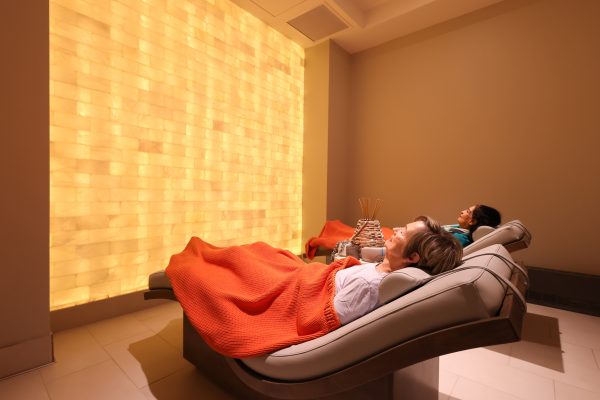Sponsored
From Glitter to Rock Bottom: A CEO’s Journey Through Addiction and Recovery
John had it all – a thriving event production company, a team of talented employees, and a reputation as the go-to guy for staging the most dazzling festivals and parties in major markets throughout the US and Canada.
As the company’s CEO and co-founder, John had built the company from the ground up with help of two business partners. Together, they had created something truly unique and robust – but beneath the surface, John battled demons that threatened to destroy him and everything he and his partners had worked so hard to build.
It started innocently enough – a bump of meth here, a drink there – anything to keep the energy and creativity flowing. “I was always one of those people who could try anything and stop,” he told the Los Angeles Blade.
But before long, John found himself in the grip of a full-blown addiction. He was sometimes zooming into the office rather than take the elevator 3 floors below from his apartment, missing important meetings, and making erratic decisions that put the entire company at risk.
At first, John tried to hide his struggle from his partners and employees, putting on a brave face and pretending everything was fine. As time when on, so did his partners and key employees, trying hard to save face. But as his addiction spiraled out of control, John’s once-sparkling world had dulled to a hazy grey visible to everyone. He began experiencing suicidal depression and looked scared and addled and was unable to see a way out.
As an LGBTQ individual, John was no stranger to adversity. He had somehow managed to remain HIV negative while most of his friends didn’t; he battled discrimination and prejudice throughout his life, but had always managed to flick it away. Now, however, he was facing a battle that felt increasingly uphill because it was a battle against himself, his own demons.
“For me, the bottom was when my entire staff and my partners held a meeting and threatened to walk,” John said. “I will never forget coming into the office only to find my mother and sister, my business partners, my staff and an intervention person: it was literally like the TV show “Intervention,” including ugly ultimatums they knew would work.”
He was whisked off to the Atlanta airport and to a facility outside of Phoenix for a one month detox and then later to Los Angeles for a 90 day program. “I honestly had no idea what I was doing. I just knew that it was a better path for me. It took some convincing but it finally made sense,” he said. “I even had business practical questions because as an entrepreneur I wasn’t sure how any of this could work: how could I take time away and regroup the staff, win my partners’ and my client’s trust back! Real questions.”
John summed it up: “But my partners both said, you won’t win us or any one else back if you remain the mess you are — we will all be broke.”
“And,” John added, “my mom reminded me to ‘be resolute,’ something I had told her when she needed to leave my father. She said, ‘those words saved my life, time to own them.’”

“Addiction doesn’t discriminate,” says Brad Lamm, founder of Breathe Life Healing Center in Los Angeles. “It doesn’t care how successful you are, how much money you make, or how many people are counting on you. It’s a disease that can take down even the strongest among us.”
For John, the turning point came when his partners confronted him about his behavior. They had noticed the changes in John’s demeanor and work ethic, and they were worried about the impact it was having on the company. It was a difficult conversation, but it was one that needed to happen.
Agreeing with his business partners about the reality of his addiction and the potential consequences for business, John knew he needed help – and fast.
But as a CEO and co-owner, he was hesitant to step away from the company for an extended period of time. He felt a deep sense of responsibility to his partners and employees, and he didn’t want to let anyone, especially his mom, down.
During his intervention he learned that under California’s labor law even as a company owner, he was protected against his own company firing him or demoting him.
Under the Family and Medical Leave Act (FMLA) and the California Family Rights Act (CFRA), John was eligible for up to 12 weeks of unpaid leave to seek treatment for his substance abuse.
He also learned that other laws strengthen those protections:
1. The Americans with Disabilities Act (ADA) and the Fair Employment and Housing Act (FEHA) prohibit discrimination against individuals with disabilities as well as individuals with substance use disorders.
2. California Gov. Newsom in 2020 signed a bill that requires employers with eligible staff members at companies with more than 5 employees (California Family Rights Act) to reasonably accommodate those who wish to enter an alcohol or drug rehabilitation program. The bill amends Labor Code section 1025, which had excluded companies with fewer than 25 employees.
3. The Affordable Care Act (ACA), requires health insurance plans to cover substance abuse treatment as an essential health benefit.
John’s partners were supportive of his decision to seek treatment, but they were also concerned about the impact his absence would have on the company. They agreed to step up and take on additional responsibilities while John was away, ensuring that the business could continue to operate smoothly.
“It was a difficult decision, but I knew I had to put my health first,” John recalls. “Knowing that my position was protected under the law gave me the peace of mind and trust I needed. And even though I realized the financial damage I had done during my worst days could result in the company’s closure, I needed to focus on me and my recovery. I had to trust that my partners could handle things in my absence, and that our clients would understand.”
John checked into a residential treatment program, where he worked with a team of specialists to confront the root causes of his addiction. It was a grueling process, full of tears and soul-searching, angry days and sleepless nights – but slowly, the fog began to lift.
As John began to heal, he also started to think about how he could create a more supportive and inclusive workplace for his employees – especially those who might be struggling with their own mental health or substance abuse issues. He worked with his partners and hired an HR team to develop new policies and programs, including a third party, confidential Employee Assistance Program (EAP) that provides confidential counseling and referral services.
“We wanted to create a culture where people felt safe and supported, no matter what they were going through,” John says. “We wanted to break down the stigma around addiction and mental health, and show our employees that it’s okay to ask for help – and that their jobs will be waiting for them when they’re ready to come back.”
Today, John is back at the helm of his company, leading alongside his partners with a newfound sense of purpose and compassion. They are vocal advocates for LGBTQ addiction awareness and mental health, using their platform to share John’s story and inspire others to seek help.
“If you are a business owner, you have a responsibility to create a workplace that is inclusive, supportive, and healthy,” John says. “That means being open and honest about our own struggles, and creating a culture where everyone feels valued and heard – and where they know that their well-being is our top priority.”
John’s journey is a powerful reminder that addiction can affect anyone, regardless of their success or status. It’s also a testament to the importance of seeking help, even when it feels impossible – and the power of having strong legal protections and a supportive network in place.
For LGBTQ individuals in particular, the barriers to treatment can be daunting. Stigma, discrimination, and a lack of culturally competent care can all make it harder to reach out for support. But there are resources available – and there is always hope.
“My journey hasn’t been easy, but it’s been worth it,” John says. “I’m a better leader, a better friend, and a better person because of the work I’ve done. And I’m committed to using my experience to help others find their way to recovery – and to create a world where no one has to choose between their health and their livelihood.”
“Don’t be afraid to ask for help,” John, now 8 years clean sober, his company thriving and producing several popular cultural fairs, arts and crafts festivals and corporate retreats, said.
“Don’t let shame or stigma keep you hopeless. With the right support and resources, you can overcome anything – and your job will be waiting for you when you’re ready to come back. I promise.”
For those seeking addiction treatment resources in Los Angeles County, there are many options available, including:
Los Angeles County Department of Public Health, Substance Abuse Prevention and Control (SAPC) – Provides a wide range of prevention, treatment, and recovery services for individuals with substance use disorders.
Breathe Life Healing Center offers provides evidence-based clinical care in a supportive environment for transformation and change.
Sponsored
6 Creative DIY Party Ideas for LGBTQ+ Celebrations

June is Pride Month, and most of the LGBTQ+ community comes together to celebrate in the shape of parades, parties, and festivals. But why limit yourself to just one month in the year to celebrate all types of love and gender expression?
You can have celebrations throughout the year and create a theme around each event to support and cheer on the queer community. From activities to drinks and snacks, there are so many ways to DIY your own unforgettable event.
1. Paint And Sip
Paint and sip events are sophisticated get-togethers, although they’ve been known to spiral into revelry every so often as the wine flows.
Setting up your own paint and sip party is easy, as long as you have access to a hobby store. Purchase a couple of canvases, oil paints, and brushes, and you’re pretty much ready to go. You should also, of course, stock up on wine or your drinks of choice.
Once your guests arrive, everyone settles down with their art supplies and starts painting. You can stick to a pride-themed painting, or have everyone paint anything they want.
2. Fabulous Casino Night
You can never go wrong with a casino night at home. Classic casino parties involve poker tables and other card games, and you can ask your guests to dress up as if they’re going to one of the top luxury casinos in Vegas.
If your friends are a bit more tech-savvy, you can show them online casino platforms, and everyone can log onto a game together to play.
It’s recommended that you get a bit of practice first if you’re new to gambling, so review resources like 99Bitcoins Telegram casino guide to practice your gambling skills on a couple of Telegram casinos before you make a fool of yourself when your guests arrive.
3. Rainbow-Themed Cocktail Evening
Who doesn’t love a rainbow-inspired event? A fun way to get everyone involved in the celebrations is to assign all your guests a color before the event, and ask them to bring the ingredients for a cocktail of that color. Think sangria for red, appletini for green, and pineapple daiquiri for yellow.
Once everyone arrives, you can get started with the mixing and tasting. As an added bit of fun, request that each of the attendees also dress up in the colors they’ve been assigned.
4. LGBTQIA+ Trivia Night
A trivia night is the perfect opportunity to test your guests’ knowledge on all things queer. Questions can include famous LGBTQIA+ personalities, organizations, or historical events.
Just be clear about the rules upfront, including how answers should be submitted and how points are scored. You should get small prizes for the winners of each round, like candy, magnets, and restaurant vouchers for the big winners.
5. Drag Bingo Night
Planning a drag bingo night is a lot of fun, but you need some organizational skills to pull it off. You will first have to hire a drag performer, or if you’re gutsy enough, dress up in drag yourself. The drag performer will act as the host, calling out the numbers and entertaining your guests.
You will also have to prepare the bingo cards. There are plenty of free online resources to help, but you will have to print out the physical cards yourself. If you feel the inspiration, customize the cards with a Pride theme.
Next, you have to source the prizes. Custom t-shirts, gift cards, or mugs are all great bingo prizes. Or, you can make a donation in the winner’s name to an LGBTQIA+ charity.
Once your guests arrive, the fun can start. Online bingo platforms can do the number draws for you, or you can do it old school-style and add a couple of numbered balls to a box.
6. Pride-Themed Movie Night
A chilled movie night can also be a fun celebration, especially if you’re watching a queer-friendly film.
Some options include:
- Brokeback Mountain
- Love, Simon
- Call Me By Your Name
- Girl
- Moonlight
- Paris Is Building
- Pariah
Invite your guests to arrive in comfy clothes or pyjamas, and create a cozy atmosphere with lots of blankets, scatter cushions, soft seating, and of course, the typical movie snacks like popcorn and pizza.
If it’s your type of thing, you can encourage discussion about the movie once it is completed, like metaphors in the film, or whether anyone has had similar experiences to the characters.
Wrapping Up
Celebrating the queer community with a party at home can be easy with a little creative inspiration and some prior planning. What really matters when hosting is how you make your guests feel. The LGBTQIA+ community often faces discrimination and other challenges, and your role as host is to provide a safe, fun, and welcoming atmosphere for everyone in attendance.
Sponsored
Forget what you thought you knew about senior living.
Bountiful amenities and myriad program offerings provide countless opportunities to explore, learn, and connect.

A focus on wellness. A wide array of concierge services, an executive pastry chef, and skilled mixologist. Technology baked into mobile apps and smart homes. Luxe touches within the big and small details that matter.
They all come together at The Mather in Tysons, Virgina, a forward-thinking Life Plan Community that upends all the stereotypes of traditional senior living. It’s a residential wellness destination for those 62 and better, consisting of 288 luxury apartment homes. And it’s 90% sold!
One of the most sought-after residences in Northern Virginia, The Mather is THE destination if you’re focused on aging well. If you want to be immersed in new cultural experiences, art, food and nature. If you expect more out of living well.
At the heart of this award-winning community is wellness, which was embedded in the design from day one. The property features 3-acres of green space with walking trails, a concert lawn and dog park – much of which is accessible to the public. You can wander through sculpture gardens, stroll on walking paths, play bocce or badminton, or linger with friends at one of the fire tables and patios.

Biophilic design throughout connects residents to the outdoors even when inside. The careful inclusion of nature within architecture is proven to nurture well-being. At The Mather, it comes to life through elements such as natural light, greenery, and wood materials which invite a sense of calm that’s often missing from modern indoor spaces. A commitment to using sustainable materials and creating a paperless environment contribute to caring for our planet.
When visiting, take time to explore the fitness center, which is equipped with advanced cardio and strength-training equipment, percussive therapy tools, and an AI-enabled body composition analyzer.
You might see residents enjoying a group class in Pilates, or practicing yoga or tai chi on the outdoor terrace. A heated indoor pool and infrared sauna are spaces for aquatic exercise and rejuvenation.
The full-service spa, Marzenia, offers a holistic menu of traditional spa treatments, including the Gharieni’s Welnamis wave bed, which uses sound and vibration to promote deep relaxation, and a Breath Lounge.
Culinary experiences at The Mather rival those of a high-end resort, with multiple on-site restaurants that curate global cuisine, as well as a bakery and pastry kitchen, and a bar+lounge with its own mixologist. Among them are all-day restaurant Maku (Finnish for savor), modern causal restaurant with outdoor seating Saam (Afrikaans for together), refined dinner venue Tashi (Tibetan for good fortune) and bar and social hub Copas (Spanish for drinks).
Staying in for the evening? Choose delivery by Gusta, a robot named for the Italian word for “enjoy,” who’ll bring a meal directly to the doorstep.
Gusta is just one way technology is integrated throughout the community. Each apartment home comes equipped with complimentary Wi-Fi and Alexa devices to control lighting, temperature, window shades, and more. Residents use digital platforms to reserve tables, request valet service, or schedule housekeeping. Of course, you can always visit, call, or text the concierge, who will personally arrange services from pet care to travel notifications.
Connection is encouraged through beautifully designed gathering spaces such as Kia Ora, a living-room lounge perfect for conversation, as well as a library stocked with books and periodicals.
Much more than a place to live, The Mather is a place to define your path to aging well, discover new interests and live boldly.
If you see yourself here, visit themathertysons.com.
Sponsored
How Sports Analytics Is Transforming Football for Fans and Players

Football has always been a game of passion, skill, and drama, but in recent years, there’s been a quiet revolution happening behind the scenes. The rise of sports analytics is changing how teams play, how coaches make decisions, and even how fans experience the beautiful game. Let’s take a closer look at how data is reshaping football from the pitch to the stands.
Moving from Gut Instinct to Data-Driven Decisions
For decades, managers relied on experience and intuition to pick their line-ups and tactics. Now, detailed statistics are at the heart of every major club’s strategy. Analysts track everything from player movement and passing accuracy to shot quality and defensive positioning. This wealth of information helps coaches fine-tune training sessions, spot weaknesses in opponents, and make smarter substitutions during matches. It’s not just about numbers—it’s about turning insights into winning results.
Analytics and the Changing Fan Experience
Fans have always loved debating team selections and match tactics, but access to advanced statistics has taken this to a new level. Supporters can now dive into heat maps, player ratings, and expected goals to back up their opinions or challenge their mates. Many enjoy following live match data on their phones or TV, adding a new layer of excitement to the action. Some even use services like online sports betting to make predictions and stay engaged with the outcomes, relying on analytics to inform their choices. This interactive approach is making football more immersive for everyone, whether you’re in the stadium or watching from home.
Analytics in Irish Football
Irish clubs and national teams are also catching the analytics wave. From the League of Ireland to the international stage, coaches are using data to scout talent, prevent injuries, and develop young players. Local fans are seeing the benefits too, with more in-depth coverage and analysis available than ever before. It’s a sign that the game is evolving, blending tradition with innovation to stay ahead in a competitive world.
Balancing the Human Side and the Numbers
While statistics are powerful, football remains a game played by people, not computers. The best managers know how to balance data with empathy and leadership. Players, too, are learning to use analytics to improve their performance without losing the creativity and flair that make the sport special. It’s this mix of science and soul that keeps football captivating for generations of fans.
Sunday World’s Unique Voice in Irish Media
For readers interested in understanding the background and early impact of the Sunday World newspaper, the RTÉ archive provides an insightful look into the Origins of Sunday World, detailing how it established its unique voice in Irish media. Just as football evolves with new technology, the media landscape has shifted, but the heart of great storytelling remains the same.
As sports analytics continues to grow, it’s clear that football’s future will be shaped by both numbers and narratives. Whether you’re a die-hard supporter or a casual viewer, there’s never been a more exciting time to be part of the game’s ongoing story.


















